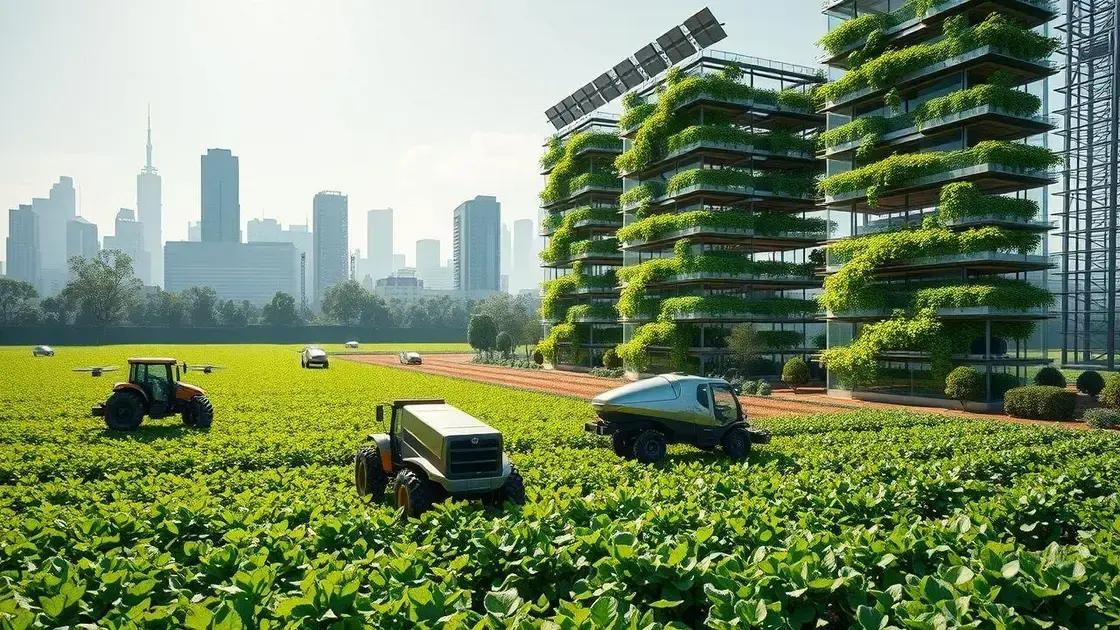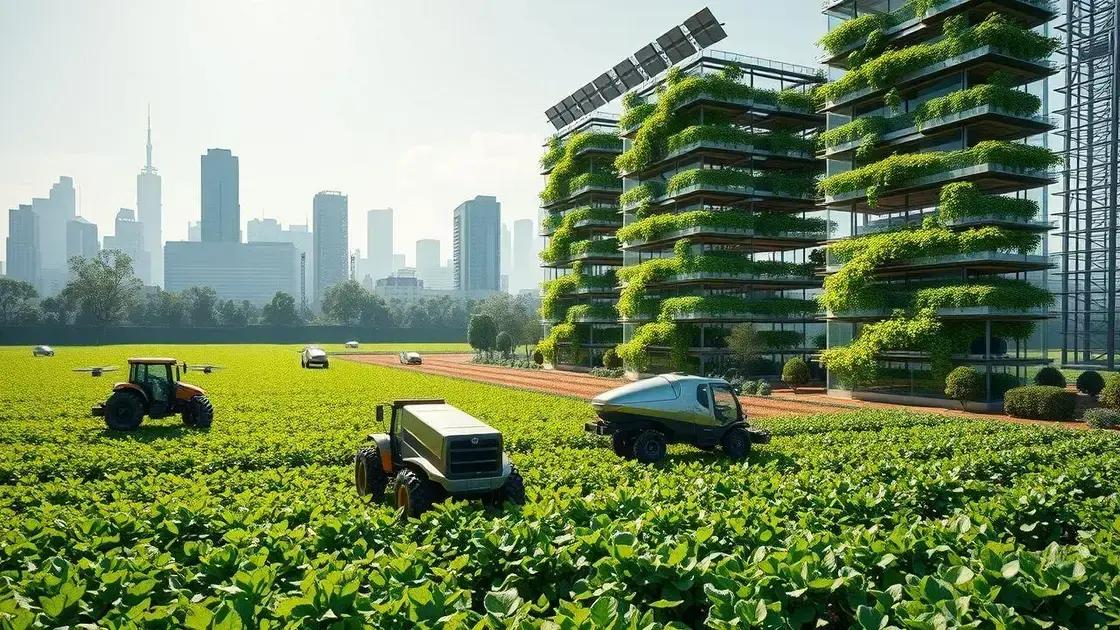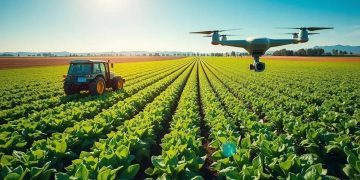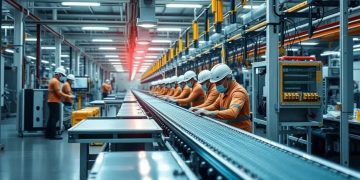Automation of vertical farming in U.S. reshapes agriculture
The automation of vertical farming in the U.S. enhances efficiency, reduces resource usage, and utilizes advanced technologies like AI and robotics to support sustainable food production in urban areas.
The automation of vertical farming in U.S. is changing how we grow food sustainably. Have you ever considered how automation could maximize efficiency and help meet rising food demands? Let’s dive in!
Understanding vertical farming automation
Understanding vertical farming automation is crucial for grasping how this innovative approach can reshape agriculture. Automation in vertical farming enhances efficiency and sustainability by utilizing advanced technologies to control growing conditions.
Vertical farms typically rely on systems that manage light, temperature, and humidity. These systems work in harmony to create optimal environments for plant growth. Automation streamlines processes that were once labor-intensive, thereby increasing productivity.
Key Components of Automation
Several key components make up the foundation of vertical farming automation:
- Climate Control Systems: Automated climate control ensures ideal conditions for plants, adjusting factors like temperature and humidity based on real-time data.
- Hydroponic Systems: These systems use nutrient-rich water instead of soil, allowing for efficient water use and reduced pest problems.
- LED Lighting: Specialized LED lights provide the perfect spectrum for plant growth, enhancing photosynthesis while using less energy than traditional lighting.
- Robotic Technologies: Robots help with planting, harvesting, and maintenance, significantly reducing labor costs.
By integrating these advanced components, vertical farming can produce high yields with lower resource consumption. Many urban areas benefit from this system, reducing the carbon footprint associated with transporting food.
As technology advances, the possibilities for automation in vertical farming continue to grow. These improvements not only support environmental sustainability but also help address the global food supply challenge. Imagine a future where fresh produce is grown nearby, available year-round, without the extensive resource use typically associated with traditional farming. This is the promise of fully automated vertical farming.
Advantages of automated vertical farming

Advantages of automated vertical farming include numerous benefits that enhance agricultural efficiency and sustainability. By implementing automation, farms can achieve higher yields while using fewer resources.
One major advantage is the reduction in labor costs. Automated systems handle tasks that typically require significant manpower. This allows human workers to focus on higher-level management and innovation roles within the farm.
Key Benefits of Automation
Here are some key benefits of automated vertical farming:
- Increased Efficiency: Automation optimizes resource use, ensuring plants get the right amount of water and nutrients at the right time.
- Consistent Quality: Automated systems provide uniform growing conditions, leading to consistent crop quality, which is essential for market demands.
- Space Utilization: Vertical farming maximizes space usage, allowing for crop production in urban areas where land is limited.
- Sustainability: Reduced water usage and lower carbon footprint make automated vertical farms more environmentally friendly compared to traditional farming methods.
As technology evolves, more farmers are embracing automation to stay competitive. Automated systems can also monitor plant health using sensors, allowing for quick responses to issues before they escalate.
The integration of renewable energy sources further enhances the sustainability of automated vertical farms. By using solar or wind energy, these farms can significantly lower their operational costs while minimizing environmental impact.
Technologies driving vertical farming automation
Technologies driving vertical farming automation are transforming agriculture by enhancing productivity and resource efficiency. Various technologies play a crucial role in this modern farming approach.
One of the key technologies is IoT (Internet of Things). IoT devices collect real-time data on plant health, moisture levels, and environmental conditions. This information helps farmers make informed decisions and optimize growth conditions.
Major Technologies in Vertical Farming
Here are some of the major technologies that support automation in vertical farming:
- Automated Nutrient Delivery Systems: These systems ensure that plants receive the right nutrients at the right times. By automating nutrient delivery, farms can enhance growth rates and improve crop quality.
- Climate Control Systems: Advanced systems adjust elements like temperature, humidity, and lighting automatically. These adjustments create the perfect environment for plant growth.
- Robotics and AI: Robots are used for planting, harvesting, and maintaining crops. AI algorithms analyze data to predict growth patterns and optimize resource use.
- LED Grow Lights: These energy-efficient lights provide the spectrum of light needed for photosynthesis. They can be programmed to simulate day and night cycles for plants.
The integration of these technologies allows vertical farms to operate more efficiently, significantly reducing labor costs while maximizing yield. With continuous advancements in technology, the future of automated vertical farming looks promising.
As farms adopt these innovations, they not only improve their operational efficiency but also contribute to sustainable food production, addressing global food security challenges. Each technological advancement represents a step towards a more efficient and sustainable agricultural industry.
Future trends in vertical farming

Future trends in vertical farming point towards significant advancements that will further revolutionize the agricultural landscape. As technology evolves, vertical farms promise to become even more efficient and sustainable.
One major trend is the increased use of artificial intelligence (AI). AI will play a crucial role in monitoring plant health, predicting crop yields, and optimizing resource use. With sophisticated algorithms, these systems will analyze data to ensure plants receive optimal growing conditions.
Sustainable Practices
An important trend in vertical farming is a focus on sustainability. As water scarcity and climate change become more pressing issues, vertical farms will likely adopt practices such as:
- Water Recycling: Implementing systems that recycle water will significantly reduce waste and improve efficiency.
- Renewable Energy: Utilizing solar and wind energy can lower carbon footprints, further enhancing sustainability.
- Organic Farming Techniques: More vertical farms are expected to embrace organic methods, reducing reliance on synthetic fertilizers and pesticides.
- Urban Integration: Vertical farms will increasingly be integrated into urban areas, providing fresh produce directly to city dwellers and reducing transportation emissions.
Another emerging trend is the rise of community-supported agriculture (CSA) through vertical farming. This model allows consumers to buy shares in a farm’s harvest, ensuring they receive fresh, locally-grown food while supporting sustainable practices.
Lastly, advancements in robotics and automation will allow for more efficient planting and harvesting processes. As robots become more capable, farms can operate with fewer workers while increasing productivity and efficiency. These trends reflect a future where vertical farming plays a significant role in food production, helping to meet the demands of a growing global population.
In conclusion, the future of vertical farming looks bright and full of possibilities. With advancements in technology like AI and automation, these farms are becoming more efficient and sustainable. They help meet the growing food demand while reducing environmental impact. As vertical farming grows in urban areas, it provides fresh produce to local communities and supports healthier lifestyles. By embracing these innovations, we can contribute to a more sustainable future and redefine the way we produce food. 🌿
\n\n
\n
\n\n\n\n\n\n\n\n\n\n\n\n\n\n\n\n\n\n\n\n\n\n\n\n\n\n\n\n\n
\n
FAQ – Frequently Asked Questions about Vertical Farming
What are the main benefits of vertical farming?
Vertical farming benefits include increased efficiency, reduced water usage, and the ability to grow food in urban areas close to consumers.
How does automation impact vertical farming?
Automation enhances productivity by using technology to manage growing conditions, reduce labor costs, and ensure consistent crop quality.
What technologies are used in vertical farming?
Technologies such as IoT devices, robotics, climate control systems, and LED grow lights are commonly used in vertical farming to optimize growth conditions.
How does vertical farming contribute to sustainability?
Vertical farming helps reduce carbon footprints, water usage, and reliance on harmful pesticides, making it a more sustainable choice for food production.





